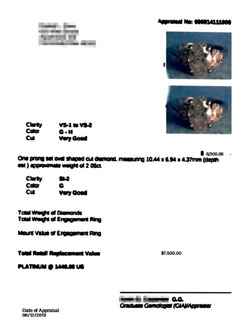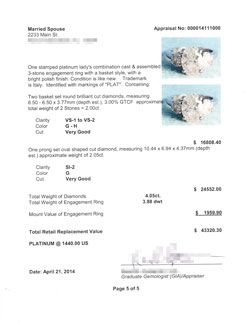Can you spot a forgery?
Some scams are subtle. They slip through easily because the clues are hidden. The deception is a success because the victim isn’t an expert.
Then there’s one like this. A respected jewelry appraiser contacted JII about an incident that involved him as an unwilling participant. It’s a true tale he thought was worth sharing.
This is an appraisal forgery so blatant, it makes us wonder whether underwriters even glance at the jewelry appraisals they receive.
Some years ago the appraiser promoted his business by introducing himself to local insurance agents and jewelry store owners. To help explain the value of a reliable descriptive appraisal, he gave them a sample of his work. The Sample — pictured at right — was not an appraisal for a real client; it was created to show what his detailed appraisals look like and how the jewelry would be described and valued.
Several years have gone by.
A few weeks ago the appraiser was contacted by an adjuster working a claim based on the appraisal shown at the top of this page. The appraiser confirmed the adjuster’s suspicions: the adjuster was looking at a forgery, which turned out to be a doctored-up version of the appraiser’s Sample.
(Note: For this story, personal information is concealed on both documents, but the fraudulent appraisal preserved the real appraiser’s name.)
So many red flags on the phony appraisal:
- The fuzzy look of the descriptive information, compared to the cleaner look of the new valuation and date, suggests that some data was photocopied and insured’s name and valuations were added afterwards. Fuzziness at left of photos shows where other info was covered before copying.
- Photos of jewelry are so fuzzy as to be useless.
- No description of ring at all (style, trademark, metal).
- Only one diamond is mentioned, but there are two sets of clarity-color-cut data. (The Sample ring included side stones as well as the center stone.)
- Lines of text for total weight of diamonds, total weight of ring, and mount value of ring are just hanging out there with no values provided.
- No signature by the appraiser.
- No contact info for appraiser. (In the Sample, this sheet was page 5 of 5; other pages included appraiser’s contact info plus other information. The fraudulent appraisal was just the one page.)
These are things that could and should have been noticed by the underwriter. To us at JII, this is a new low in unreliable appaisals!
We are left to wonder:
How often does this sort of thing occur?
Was this same phony appraisal submitted to other insurers—followed by loss claims to those insurers? The Sample was distributed several years ago, meaning there’s been plenty of time for multiple scams.
Did the fraudster adulterate the Sample in different ways for dfferent insurers? The same “appraisal” with a different customer name and different valuation would camouflage the scam, even if losses were reported to CLUE.
Was the valuation so low that some insurers would simply make a cash settlement without going to an outside adjuster?
Who is the fraudster here? If it is the consumer, how did they come to have the Sample appraisal that was given only to agents and jewelers?
Is an agent or jeweler in on the scam?
We don’t know. But we can say that, as least this time, an attentive adjuster saved the insurer having to pay on a fraudlent claim.
FOR AGENTS & UNDERWRITERS
Valuation isn’t the only important thing on an appraisal. See What to look for on a jewelry appraisal for a discussion of the importance of a detailed description of the jewelry as well as other information.
It is easy to produce a paper and call it an appraisal, so be wary if anything on an appraisal looks suspicious. In the case above, for example, the adjuster first noticed that there was no appraiser signature—and that led him to notice other problems.
As we discussed in Jeweler/Appraiser Credentials, literally anyone can call themself an appraiser. There is no independent body setting qualifications for this title. Bogus jewelry appraisals and inflated valuations are extremely common.
Photos must be clear enough to show what the jewelry looks like. Either agent or customer can take very usable jewelry photos with today’s smart phones. How photos cut fraud gives several scenarios in which photos are useful.
Of course the higher the valuation, the more careful you should be in checking the appraisal. However, as the above experience suggests, fraudsters can make a good haul by perpetrating multiple low-value scams that can fall below the insurers’ radar.
FOR ADJUSTERS
Be wary if anything on an appraisal looks suspicious, and use every means possible to track down the truth. Bogus appraisals abound.
In the case above, the adjuster first noticed that there was no appraiser signature, nor was there contact information for the appraiser. The adjuster went online and found that the name listed was indeed an appraiser, and the appraiser was a Graduate Gemologist of the GIA, as stated. A call to the appraiser revealed that this fraudulent appraisal – which purposely used the name of a credentialed appraiser – was the backbone of a claim scam.
We can now add this advice: verify the appraisal by requesting a copy from the appraiser, then compare it to the appraisal on file.
Untrustworthy jewelry appraisals or certificates — with inflated valuations — are rampant. If the valuation on an appraisal is much higher than the purchase price, the valuation is probably inflated.
Certification labs used by large retailers supply documents with titles such as “summation of appraisal” or “appraisal report” or “identification report.” The valuations are typically exaggerated to impress the customer.
Base settlement on descriptive information available on the appraisal, lab report, etc., not on valuation.
Do not automatically turn to the seller for replacement, especially if it is a large retailer.
©2000-2025, JCRS Inland Marine Solutions, Inc. All Rights Reserved. www.jcrs.com



